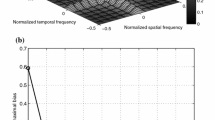Abstract
In this paper, we mainly study the system design of sparse microwave imaging radar and report some of the preliminary results of airborne experiments performed with it. Sparse microwave imaging radar is a novel concept which introduces the sparse signal processing theory to microwave imaging replacing the conventional matched filtering processing method. With the exploitation of the sparse microwave imaging, the radar system could achieve better performance. As a newly developed concept, the two main types of applications of sparse microwave imaging are found in adopting the sparse signal processing theory to current radar systems, and in designing an optimized sparse microwave imaging system. Here we are trying the latter that mainly aims at lower PRF and wider swath. We first introduce the theories of sparse microwave imaging radar and its imaging algorithm. Then we discuss the system designing principles, including the sampling scheme, signal bandwidth, SNR and multi-channel mode. Based on the relationships of these parameters, we provide a design example of radar parameters. In the end, we exploit an airborne experiment using our designed radar system with jittered azimuth sampling strategy. Some preliminary analysis from the experiment result is also provided.
Similar content being viewed by others
References
Baraniuk R G, Candès E, Elad M, et al. Applications of sparse representation and compressive sensing. Proc IEEE, 2010, 98: 906–909
Donoho D L. Compressed sensing. IEEE Trans Inf Theory, 2006, 52: 1289–1306
Candès E J, Tao T. Near-optimal signal recovery from random projections: universal encoding strategies? IEEE Trans Inf Theory, 2006, 52: 5406–5425
Candès E J, Romberg J K, Tao T. Stable signal recovery from incomplete and inaccurate measurements. Commun Pure Appl Math, 2006, 59: 1207–1223
Hu L, Zhou J X, Shi Z G, et al. Compressed sensing of superimposed chirps with adaptive dictionary refinement. Sci China Inf Sci, 2013, 56: 122302
Rao W, Li G, Wang X Q, el al. Comparison of parametric sparse recovery methods for ISAR image formation. Sci China Inf Sci. 2014, 57: 022315
Zhang B C, Hong W, Wu Y. Sparse microwave imaging: principles and applications. Sci China Inf Sci, 2012, 55: 1722–1755
Ender J H G. On compressive sensing applied to radar. Signal Process, 2010, 90: 1402–1414
Jiang C L, Zhang B C, Zhang Z, et al. Experimental results and analysis of sparse microwave imaging from space-borne radar raw data. Sci China Inf Sci, 2012, 55: 1801–1815
Currie A, Brown M A. Wide-swath SAR. IEE Proc Radar signal process, 1992, 139: 122–135
Zhang Z, Zhang B C, Jiang C L, et al. Influence factors of sparse microwave imaging radar system performance: approaches to waveform design and platform motion analysis. Sci China Inf Sci. 2012, 55: 2301–2317
Fang J, Xu Z, Zhang B, et al. Fast compressed sensing SAR imaging based on approximated observation. IEEE J Sel Top Appl Earth Obs Rem Sens, 2014, 7: 352–363
Krieger G, Gebert N, Moreira A. Unambiguous SAR signal reconstruction from nonuniform displaced phase center sampling. IEEE Geosci Rem Sens Lett, 2004, 1: 260–264
Fang J, Zeng J S, Xu Z B, et al. Efficient DPCA SAR imaging with fast iterative spectrum reconstruction method. Sci China Inf Sci, 2012, 55: 1838–1851
Raney R K, Runge H, Bamler R, et al. Precision SAR processing using chirp scaling. IEEE Trans Geosci Rem Sens, 1994, 32: 786–799
Daubechies I, Defrise M, De Mol C. An iterative thresholding algorithm for linear inverse problems with a sparsity constraint. Commun Pure Appl Math, 2004, 57: 1413–1457
Tian Y, Jiang C L, Lin Y G, et al. An evaluation method for sparse microwave imaging radar system using phase diagrams. In: Proceedings of CIE Radar Conference, Chengdu, 2011
Candès E, Romberg J. Sparsity and incoherence in compressive sampling. Inverse Probl, 2007, 23: 969–985
Patel V M, Easley G R, Healy D, et al. Compressed synthetic aperture radar. IEEE J Sel Top Signal Process, 2010, 4: 244–254
Balakrishnan A. On the problem of time jitter in sampling. IRE Trans Inf Theory, 1962, 8: 226–236
Geng B, Zhang H J, Wang H, el al. Approximate Poisson disk sampling on mesh. Sci China Inf Sci. 2013, 56: 092117
Curlander J C, McDonough R N. Synthetic Aperture Radar: Systems and Signal Processing. New York: Wiley, 1991
Cumming I G, Wong F H. Digital Signal Processing of Synthetic Aperture Radar Data: Algorithms and Implementation. Artech House, 2004
De Zan F, Guarnieri A M. TOPSAR: terrain observation by progressive scans. IEEE Trans Geosci Rem Sens, 2006, 44: 2352–2360
Raney R K, Luscombe A P, Langham E, et al. Radarsat. Proc IEEE, 1991, 79: 839–849
Author information
Authors and Affiliations
Corresponding author
Rights and permissions
About this article
Cite this article
Zhang, B., Zhang, Z., Jiang, C. et al. System design and first airborne experiment of sparse microwave imaging radar: initial results. Sci. China Inf. Sci. 58, 1–10 (2015). https://doi.org/10.1007/s11432-014-5266-6
Received:
Accepted:
Published:
Issue Date:
DOI: https://doi.org/10.1007/s11432-014-5266-6
Keywords
- sparse microwave imaging
- synthetic aperture radar (SAR)
- compressive sensing
- displaced phase center antenna (DPCA)
- system design
- airborne experiment




